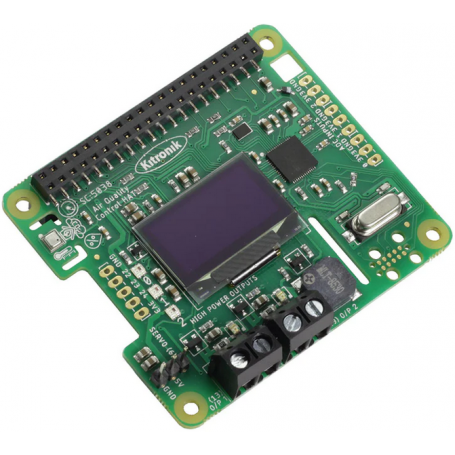Air Quality DataLogging HAT pour Raspberry-Pi
Environmental Measures Hat and Air Quality for Raspberry-Pi
- BME688 (pressure, temp., Humidity, eCO2, CoV)
- Ecran OLED 128x64,
- Buzzer
- LED RGB (NeoPixel/Zip)
- 3x Analog input (3.3v)
- 3x GPIO (3.3v)
- 2x Power output
Payments are secured by LyraCollect, a French payment collection company.
It is possible to delivered to your home, to a pick-up point or picked up by appointment at MCHobby
We prepare, pack and ship your orders with great respect and care.
Experimentation Swiss knife for Raspberry and Air quality datalog/monitoring
After the version for Pico, Kitronik is doing it again with an air quality measurement board for Raspberry-Pi. This time, it is in the form of a Hat that this multi-functional tool is offered to us. A tool of choice for exploration and environmental monitoring but also for many other Raspberry-Pi applications since this Hat has a display, RGB LEDs (called NeoPixels), a buzzer... all this needed to set up a mini-lab.
Kitronik's HAT Air Quality Control offers a series of sensors and connection points for Raspberry Pi and offers the possibility of environmental monitoring with the OLED display, storage of environmental information (datalog) on the file system of the Raspberry-Pi, alert with its buzzer and RGB LEDs.
The HAT Air quality Control also offers inputs/outputs for connecting analog sensors, motors, servo motors and even a heating element. This Hat can therefore act on its environment... from there to creating a small didactic greenhouse, there is only one step!
The HAT can acquires data from the BME688, a Bosch sensor designed for environmental and air quality monitoring. Thanks to this sensor, the HAT is able to measure:
- The temperature: -45°C to +85°C
- The atmospheric pressure: 300 hPa to 1100 hPa
- The relative humidity: 0 to 100% RH
- Air Quality Index: 0=Excellent, 500=Extremely polluted
- eCO2 : 250ppm to 40000+ ppm
CO2 equivalent. If the CO2 do increase then the oxygen quantity decrease. It will be right time to ventilate the room.
The white-on-black OLED display offers a resolution of 128x64 pixels. The interest of OLED screens is that each pixel produces its own light. These display offers a perfect readability even in very bright environments..
The 3 RGB LEDs can be used to display status (named ZIP at Kitronik, these LEDs are also known as NeoPixel). Thanks to these RGB LEDs it is possible to provide a visual feedback of a level of concentration (EG: in the case of CO2: green=low concentration, orange=concentration increases, red=high concentration, flashing red=critical concentration). The Piezo Buzzer will also be welcome to provide an alert.
The Air Quality Control HAT also have additional connection pads:
- 2x 1A outputs,
- 1x Servo output
- 3x Analog input (wired on the RP2040 ADCs)
Some other GPIOs are available on a breakout connector (2.54mm spacing, accompanied with GND and 3V).
Finally, this HAT comes with a Python library ( pip install KitronikAirQualityControlHAT ) and examples code: https://github.com/KitronikLtd/Kitronik-Raspberry-Pi-Air-Quality-Control-
HAT-Python
Hat for Raspberry-Pi
This board is a Hat for Raspberry-Pi. It is powered by the Raspberry-Pi. The Hat is compatible with versions of the Pi offering a 40-pin GPIO connector (Pi 2, Pi 3, Pi 4, Pi Zero 2).
To use this card, turn off the Raspberry-Pi then position carefully the card over the GPIO. Finally, firmly press the card on the GPIO connector.
Content
For each order, you will receive a Air Quality Control HAT completely assembled and tested. The Raspberry-Pi, motors, and other items are not included.
Technical details
- Powering: 5V, through the Raspberry-Pi GPIO
- Power output: GPIO13 & GPIO19 (1 Amp max)
- Servo output: GPIO26 (and supply voltage)
- Piezo Buzzer: GPIO26
- Analog inputs: 3.3V max, using the RP2040 analog input
- Input/output breakout: GPIO22, 23 et 24 (fitted with 3.3V and GND)
- BME688 & OLED: GPIO2 & GPIO3 (I2C bus)
- Technical datasheet and example code (pdf, Kitronik, english)
Tutorial
- Air Quality Control Hat (Kitronik, english)
- Technical datasheet and example (pdf, Kitronik, english)
- Python code example (Kitronik, GitHub)
- Qualité d'air intérieur (partie 1): Introduction (MCHobby, Français)
Une série de tutoriel pour bien comprendre la qualité d'air. - Qualité d'air intérieur (parie 2): mesure de CO2 (MCHobby, Français)
- Qualité d'air intérieur (partie 3): Mesure de CoV (MCHobby, Français)
- Raspberry Compatibility
- Zero / Zero W, Pi 3A, Pi 3B+, Pi 4, Pi 400/500, Pi 5, Zero 2 W
- Interface : Connector
- HAT (RPi GPIO)









